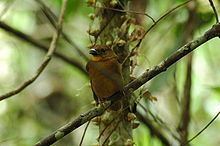Order Passeriformes Scientific name Habia Rank Genus | Phylum Chordata Family Cardinalidae Higher classification Cardinal | |
 | ||
Lower classifications Red‑throated ant tanager, Red‑crowned ant tanager, Crested ant tanager, Black‑cheeked ant tanager, Sooty ant tanager | ||
Ant tanagers are birds of the genus Habia. These are long-tailed and strong billed birds. The males have a red crest and plumage containing red, brown or sooty hues. Females may resemble the males or be largely yellowish or brown in colour. Formerly placed in the tanager family (Thraupidae), they are actually closer to Cardinalis in the Cardinalidae. Consequently, it can be argued that referring to the members of this genus as ant-tanagers is misleading, but no other common name has gained usage.
All species forage for insects, which can be larger than their bills. Fruit is a minor part of their diet. red-throated, sooty and black-cheeked ant tanagers form a superspecies; they inhabit second growth and patchy woodland. They look down from a series of low (2–3 m) perches and take prey from foliage or in flight. They follow army ant swarms to catch insects that are fleeing from the ants.
Red-crowned and crested ant tanagers prefer denser undergrowth and watch from higher (4–5 m) perches, often working upwards through the foliage. They are less likely to follow ant columns.
The female alone builds a cup nest and incubates the two or three eggs. The young leave the nest before they can fly and hide in dense vegetation.
Ant-tanagers have harsh call notes but musical whistled songs.
